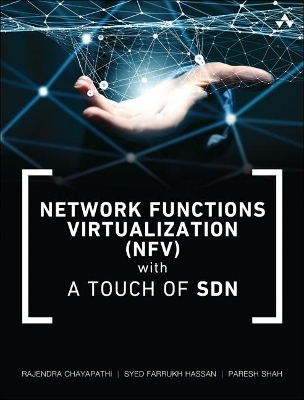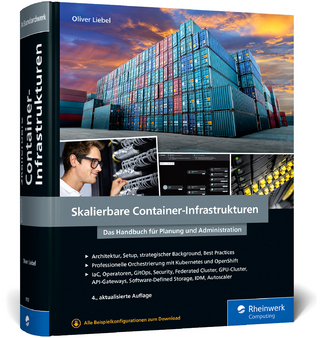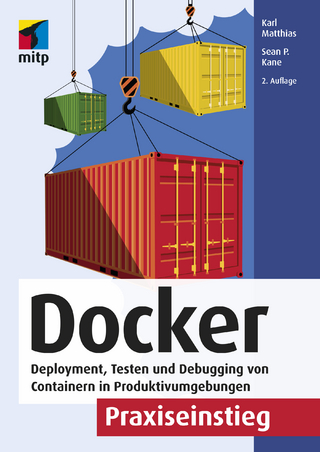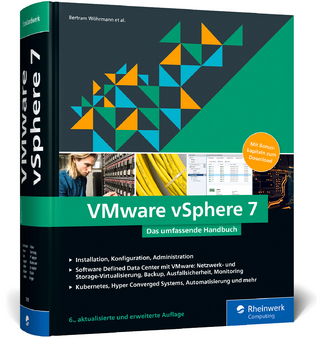
Network Functions Virtualization (NFV) with a Touch of SDN
Addison Wesley (Verlag)
978-0-13-446305-6 (ISBN)
- Titel z.Zt. nicht lieferbar
- Versandkostenfrei innerhalb Deutschlands
- Auch auf Rechnung
- Verfügbarkeit in der Filiale vor Ort prüfen
- Artikel merken
Network Functions Virtualization (NFV) with a Touch of SDN is the first practical introduction to NFV’s fundamental concepts, techniques, and use cases. Written for wide audiences of network engineers, architects, planners, and operators, it assumes no previous knowledge of NFV architecture, deployment, or management.
The authors first explain how virtualization, VMs, containers, and related technologies establish the foundation for the NFV transformation. Next, they show how these concepts and technologies can be applied to virtualize network functions in the cloud, data centers, routing, security, and the mobile packet core.
You’ll discover new tools and techniques for managing and orchestrating virtualized network devices, and gain new clarity on how SDN and NFV interact and interrelate. By the time you’re done, you’ll be ready to assess vendor claims, evaluate architectures, and plan NFV’s role in your own networks.
Understand NFV’s key benefits and market drivers
Review how virtualization makes NFV possible
Consider key issues associated with NFV network design and deployment
Integrate NFV into existing network designs
Orchestrate, build, and deploy NFV networks and cloud services
Maximize operational efficiency by building more programmable, automated networks
Understand how NFV and SDN work together
Address security, programmability, performance, and service function chaining
Preview evolving concepts that will shape NFV’s future
Rajendra Chayapathi is a Senior Solution Architect in Cisco’s professional and consulting services organization. His most recent work has been on emerging technologies such as NFV, SDN, programmability and network orchestration and its adoption in the industry. He has over twenty years of experience in networking technologies, customer interaction, and networking products; his focus is on network design and architecture. He has previously worked in Cisco’s engineering teams where he was involved on various network operating systems and product development. Before his employment at Cisco, he provided consultancy services to AT&T and financial institutions for the design and deployment of IP core network technologies. He has been a regular speaker at multiple technology conferences such as Cisco Live, Cisco Connect and NANOG. Rajendra has a CCIE (#4991) in Routing and Switching and also holds a Bachelor’s degree in Electronics and Communication from University of Mysore, India and a Masters’ degree in Business Administration with a focus on technology Management from University of Phoenix, USA. Syed Farrukh Hassan has been in the networking industry for fifteen years, and is currently a Senior Solutions Architect in Cisco’s professional and consulting services organization. He has worked with various Internet and cloud service providers, helping them in adoption of innovative network technologies and supporting them in design and deployment of new architectures. In his current role, Syed is involved in SDN and NFV adoption, providing guidance, future strategy, and planning to service provider, enterprise, and data center customers. Syed has previously been part of engineering teams within Cisco and has been an active contributor towards design and innovation of network products and solutions. Syed has been a regular speaker in public forums and conferences and is recognized as a Cisco Live Distinguished Speaker. Syed is a double CCIE in Service Provider and Data Center technologies (#21617) and also a VMware Certified Network Virtualization Professional (VCP-NV). He holds a Bachelors’ degree in Engineering from NED University, Pakistan, and a Masters’ degree in Engineering from the University of Florida, Gainesville, USA. Paresh Shah has been in the network industry for more than twenty years and currently working as a Director in Cisco’s professional and consulting services organization. He is responsible for bringing to market new disruptive services based on cutting-edge technologies and solutions to achieve successful deployment in customer networks. Paresh has led various global engineering and customer-facing groups in the service provider market and is a veteran of the high-end routing, service provider, enterprise, and cloud segments. He started his career as an engineer in 1996 building one of the first high-speed multi-services routers in the industry and was responsible for adoption of new technologies then, like MPLS, BGP, and L2/L3 VPN and new operating systems like IOS-XR. Paresh is leading the adoption of NFV, SDN, and segment routing consultancy services and driving the solutions for cloud-providers, traditional service providers, and enterprises that are looking to adopt these new technologies. Paresh is a regular speaker at industry conferences such as Cisco Live, NANOG, and SANOG, with a pulse on the latest trends in the industry. He has a Bachelors’ degree in Electrical Engineering from University of Pune, India and a Masters’ degree focusing in Networking and Telecommunications from University of Missouri-Kansas City, USA.
Preface . . . . . . . . . . . . . . . . . . . . . . . . . . xiii
Acknowledgments . . . . . . . . . . . . . . . . . . . . . . xv
About the Authors . . . . . . . . . . . . . . . . . . . . . xvii
About the Technical Reviewers . . . . . . . . . . . . . . . . . . xix
Introduction . . . . . . . . . . . . . . . . . . . . . . . . . xxi
Chapter 1: The Journey to Network Functions Virtualization (NFV) Era . . .1
The Evolution of Network Architecture . . . . . . . . . . . . . 1
Traditional Network Architecture . . . . . . . . . . . . . 2
Introducing NFV . . . . . . . . . . . . . . . . . . . 5
NFV Architectural Framework . . . . . . . . . . . . . . . . . 7
Need for a Framework . . . . . . . . . . . . . . . . . 7
ETSI Framework for NFV . . . . . . . . . . . . . . . . 8
Understanding the ETSI Framework . . . . . . . . . . . 10
A Closer Look at ETSI’s NFV Framework . . . . . . . . . 13
NFV Framework Summary . . . . . . . . . . . . . . . 26
Benefits of NFV . . . . . . . . . . . . . . . . . . . . . . 26
Hardware Flexibility . . . . . . . . . . . . . . . . . 27
Faster Service Life Cycle . . . . . . . . . . . . . . . . 28
Scalability and Elasticity . . . . . . . . . . . . . . . . 28
Leveraging Existing Tools . . . . . . . . . . . . . . . 29
Rapid Development and Vendor Independence . . . . . . . 29
Validation of New Solutions . . . . . . . . . . . . . . 29
Amorphous Service Offering . . . . . . . . . . . . . . 29
Operational Efficiency and Agility . . . . . . . . . . . . 30
NFV Market Drivers . . . . . . . . . . . . . . . . . . . . 31
Movement to Cloud . . . . . . . . . . . . . . . . . . 31
New Business Services . . . . . . . . . . . . . . . . . 32
Capital Expense Savings . . . . . . . . . . . . . . . . 33
Operational Expense Savings . . . . . . . . . . . . . . 33
Barrier of Entry . . . . . . . . . . . . . . . . . . . 34
Summary . . . . . . . . . . . . . . . . . . . . . . . . . 34
References . . . . . . . . . . . . . . . . . . . . . . . . 34
Review Questions . . . . . . . . . . . . . . . . . . . . . 35
Chapter 2: Virtualization Concepts . . . . . . . . . . . . . . . .37
History and Background of Virtualization . . . . . . . . . . . . 37
Virtualization Benefits and Goals . . . . . . . . . . . . 40
Server Virtualization, Network Virtualization, and NFV . . . 41
Virtualization Techniques . . . . . . . . . . . . . . . 45
Virtualization versus Emulation . . . . . . . . . . . . . 49
Virtual Machines . . . . . . . . . . . . . . . . . . . . . . 50
Components of a Virtual Machine . . . . . . . . . . . . 50
Resource Allocation to the Virtual Machine . . . . . . . . 53
Network Communication . . . . . . . . . . . . . . . 55
Packaging a Virtual Machine . . . . . . . . . . . . . . 58
Commonly Used Hypervisors . . . . . . . . . . . . . . 62
Linux Containers and Docker . . . . . . . . . . . . . . . . . 64
Understanding Containers . . . . . . . . . . . . . . . 65
Container versus Virtual Machines . . . . . . . . . . . . 67
Application Container and OS Container . . . . . . . . . 70
Enter Docker . . . . . . . . . . . . . . . . . . . . 72
Container Packaging–Beyond Docker . . . . . . . . . . 76
Single and Multitenant Environment . . . . . . . . . . . . . . 76
Virtualization and NFV . . . . . . . . . . . . . . . . . . . 78
Summary . . . . . . . . . . . . . . . . . . . . . . . . . 78
References . . . . . . . . . . . . . . . . . . . . . . . . 79
Review Questions . . . . . . . . . . . . . . . . . . . . . 79
Chapter 3: Virtualization of Network Functions . . . . . . . . . . .83
Designing NFV Networks . . . . . . . . . . . . . . . . . . 83
NFV Design Considerations . . . . . . . . . . . . . . 84
NFV Transformation Challenges . . . . . . . . . . . . 105
Virtualization of Network Infrastructure and Services . . . . . . . 118
NFV for Routing Infrastructure . . . . . . . . . . . . 118
Virtualization of Network Security . . . . . . . . . . . 127
Virtualization of Mobile Communication Networks . . . . 129
Summary . . . . . . . . . . . . . . . . . . . . . . . . 133
References . . . . . . . . . . . . . . . . . . . . . . . . 134
Review Questions . . . . . . . . . . . . . . . . . . . . . 134
Chapter 4: NFV Deployment in the Cloud . . . . . . . . . . . . .137
What’s in a Cloud? . . . . . . . . . . . . . . . . . . . . 137
Characteristics of Cloud . . . . . . . . . . . . . . . 139
Cloud-Based Services . . . . . . . . . . . . . . . . 140
Cloud Deployment Models . . . . . . . . . . . . . . 142
NFV and Cloud . . . . . . . . . . . . . . . . . . . 144
Revisiting ETSI Management and Orchestration Block . . . . . . 145
MANO Data Repositories . . . . . . . . . . . . . . 147
Orchestrating, Deploying, and Managing NFV Infrastructure . . . . 157
Hardware Virtualization Deployment Options . . . . . . . 158
Deploying Virtual Machines and Containers . . . . . . . 160
Software and Tools for NFVI Deployment . . . . . . . . 164
Introduction to OpenStack . . . . . . . . . . . . . . . . . 167
So What Is OpenStack? . . . . . . . . . . . . . . . . 167
A Brief History of OpenStack . . . . . . . . . . . . . 168
OpenStack Releases . . . . . . . . . . . . . . . . . 169
OpenStack Deployment Nodes . . . . . . . . . . . . . 169
OpenStack Networking . . . . . . . . . . . . . . . . 183
OpenStack Deployment Nodes Revisited . . . . . . . . . 192
OpenStack High Availability . . . . . . . . . . . . . . 193
Live Migration for VNF mobility . . . . . . . . . . . . 200
Deploying OpenStack . . . . . . . . . . . . . . . . 201
Using OpenStack as VIM . . . . . . . . . . . . . . . 204
Life Cycle Management of VNFs . . . . . . . . . . . . . . . 211
VNFM Software Examples . . . . . . . . . . . . . . 213
Orchestration and Deployment of Network Services . . . . . . . 214
Cisco’s Network Service Orchestrator . . . . . . . . . . 214
Telefonica’s OpenMANO . . . . . . . . . . . . . . . 214
Brocade VNF Manager . . . . . . . . . . . . . . . . 215
Nokia’s CloudBand Network Director . . . . . . . . . . 215
Ciena’s Blue Planet . . . . . . . . . . . . . . . . . 215
HP’s NFV Director . . . . . . . . . . . . . . . . . 215
Ericsson Cloud Manager . . . . . . . . . . . . . . . 215
OpenStack Tracker . . . . . . . . . . . . . . . . . 216
RIFT.io’s RIFT.ware . . . . . . . . . . . . . . . . . 216
NFV MANO and Open Source Solutions . . . . . . . . . . . . 216
Open Platform NFV . . . . . . . . . . . . . . . . . 216
Open Orchestration Project (Open-O) . . . . . . . . . . 218
Open Source MANO (OSM) . . . . . . . . . . . . . 218
Describing Network Service Descriptor . . . . . . . . . . . . 219
Juju Charms . . . . . . . . . . . . . . . . . . . . 219
HOT . . . . . . . . . . . . . . . . . . . . . . . 219
TOSCA . . . . . . . . . . . . . . . . . . . . . . 220
Summary . . . . . . . . . . . . . . . . . . . . . . . . 222
References . . . . . . . . . . . . . . . . . . . . . . . . 222
Review Questions . . . . . . . . . . . . . . . . . . . . . 224
Chapter 5: Software Defined Networking (SDN) . . . . . . . . . . .227
Basic Concepts of SDN . . . . . . . . . . . . . . . . . . . 227
What is SDN? . . . . . . . . . . . . . . . . . . . 230
Advantages of SDN . . . . . . . . . . . . . . . . . 231
SDN Implementation and Protocols . . . . . . . . . . . . . . 234
Introduction to SDN Controller . . . . . . . . . . . . 234
SDN Implementation Models . . . . . . . . . . . . . 235
SDN Protocols . . . . . . . . . . . . . . . . . . . 238
SDN Use-Cases for Different Networking Domains . . . . . . . . 251
SDN in the Data Center (SDN DC) . . . . . . . . . . . 251
SDN in Service Provider Cloud (SP SDN) . . . . . . . . . 254
SDN in Wide-Area Networks (SD WAN) . . . . . . . . . 257
Enterprise SDN . . . . . . . . . . . . . . . . . . . 260
Transport SDN . . . . . . . . . . . . . . . . . . . 262
Revisiting SDN Controllers . . . . . . . . . . . . . . . . . 265
Open Source SDN Controllers . . . . . . . . . . . . . 265
Commercial SDN Controllers . . . . . . . . . . . . . 269
SDN Correlation with NFV . . . . . . . . . . . . . . . . . 273
CORD–An Example of NFV and SDN Working Together . . 276
Summary . . . . . . . . . . . . . . . . . . . . . . . . 281
References . . . . . . . . . . . . . . . . . . . . . . . . 282
Review Questions . . . . . . . . . . . . . . . . . . . . . 283
Chapter 6: Stitching It All Together . . . . . . . . . . . . . . . .285
Security Considerations . . . . . . . . . . . . . . . . . . 285
Service Function Chaining . . . . . . . . . . . . . . . . . 287
Service Chaining in a Traditional Network . . . . . . . . 288
Service Function Chaining for Cloud Scaling . . . . . . . 289
Network Service Header (NSH) . . . . . . . . . . . . 294
Other Protocols for SFC . . . . . . . . . . . . . . . 302
Service Chaining Use Case . . . . . . . . . . . . . . 302
How Virtual Machines Communicate . . . . . . . . . . . . . 304
Virtual Switch . . . . . . . . . . . . . . . . . . . 305
Single Root Input/Output Virtualization and
Sharing (SR-IOV) . . . . . . . . . . . . . . . . . 306
Direct Memory Access . . . . . . . . . . . . . . . . 307
Enhancing vSwitch Performance . . . . . . . . . . . . . . . 308
Data Plane Development Kit (DPDK) . . . . . . . . . . 309
Vector Packet Processing (VPP) . . . . . . . . . . . . . 310
Data Performance Considerations . . . . . . . . . . . . . . 314
CPU Usage Optimization . . . . . . . . . . . . . . . 315
Optimized Use of Memory . . . . . . . . . . . . . . 317
Programmability in a Virtualized Network . . . . . . . . . . . 317
Summary . . . . . . . . . . . . . . . . . . . . . . . . 321
References . . . . . . . . . . . . . . . . . . . . . . . . 322
Review Questions . . . . . . . . . . . . . . . . . . . . . 322
Appendix A: Answers to Review Questions . . . . . . . . . . . . 325
9780134463056, TOC, 10/28/2016
| Erscheinungsdatum | 04.01.2017 |
|---|---|
| Verlagsort | Boston |
| Sprache | englisch |
| Maße | 179 x 229 mm |
| Gewicht | 588 g |
| Themenwelt | Informatik ► Betriebssysteme / Server ► Virtualisierung |
| Mathematik / Informatik ► Informatik ► Netzwerke | |
| ISBN-10 | 0-13-446305-6 / 0134463056 |
| ISBN-13 | 978-0-13-446305-6 / 9780134463056 |
| Zustand | Neuware |
| Haben Sie eine Frage zum Produkt? |
aus dem Bereich


